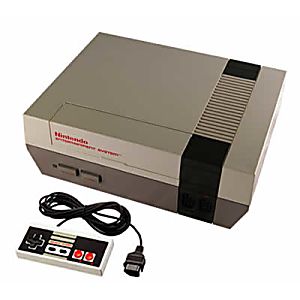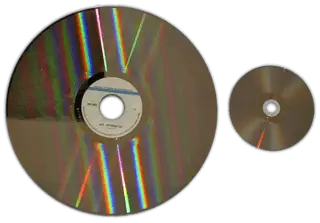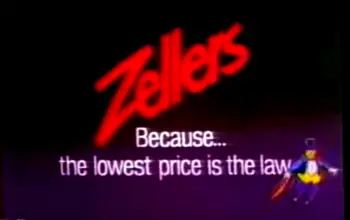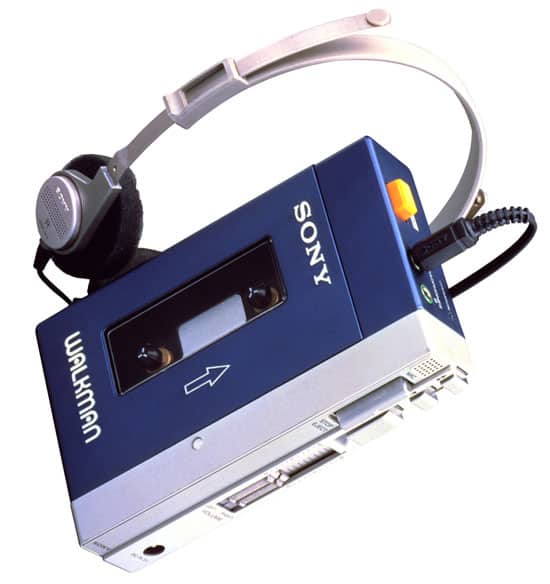
No matter what way you choose to listen to music today; phone, iPod or any other listening device do you remember what started it all?
The
If you’re like me you grew up on cassettes and one of the best presents I ever got was a duel cassette recorder. Do you remember these? The real main point was that you could now copy cassettes and Lord willing, you had one that had high-speed dubbing in order to quicken the process. Looking back this might have been the first form of music piracy that would set the stage for Napster down the road.
But at the time, hello mixtapes!
Either way, if you remember, and used cassettes, you know at some point you wanted to take your music on the go. A ghetto blaster was cool af but not the transportable music you hoped for. Plus the big ones had to be hooked up to car batteries. Sony helped solve this problem in 1979 allowing the ‘80s to be transformed with the walkman.
Early Listening Devices That Came Before The Walkman
The Walkman definitely wasn’t the first portable listening device, and would not be the last, but it’s what took allowing your music to travel with you to the next level. The ubiquitous yellow design and headphones would become synonymous with portable music the same way the iPod and the white earbuds would a few decades later.
The thing is we already had the technology. It just took the foresight to create better packaging and ease of use much the same way Steve Jobs did with MP3 players. The concept of the Walkman – a magnetic tape player – had been around since 1963 in the Netherlands where Phillips had first created it. It’s original intention was to be used for quick playback for secretaries or Journalists.
There were also other portable extronics such as transistor radios. You were limited to what was being played on the radio but at least you still had the option to take music on the go with you. Electronics powerhouse Sony had always been a part of this technology and had introduced a small transistor radio way back in 1955 when a young Marty McFly struggled not to break up his parents.
Cassette tapes were introduced in the 60’s and even though they were embraced, people still preferred listening to vinyl. The appeal of cassettes however was that they were small and compact and would lend themselves better to car stereos than obviously vinyl would. Or even 8-track players.
R.I.P
How The Walkman First Got Developed
Like many inventions, the Walkman was a solution to a problem. The co-founder of Sony, Masaru Ibuka, would use a Sony product called the TC-D5 cassette recorder to be able to listen to music while traveling. This bulking piece of electronics wasn’t the most conducive thing for carrying around and he asked executive deputy president Norio Ohga to design a smaller device that was only meant for playback. He also wanted it to have stereo sound to better enjoy his music and that it could be listened to on headphones.
The first prototype was built from a modified “Sony Pressman” which was a mono cassette recorder. The pressman also had a bit of an interesting name…
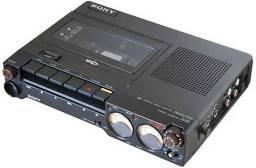
The Walkman was finally put together and was made of a silver and blue metal case and was called “TPS-L2” (how are you coming on those TPS reports?) It would be considered the world’s first low cost portable stereo. It was originally released in Japan on July 1 1979 and sold for close to 40,000 yen.
At the time this was the equivalent of around $150.00 U.S dollars and if you adjust for inflation it was the equivalent of about $498.66. That’s a big chunk of change and I had no idea they went for that price. I guess if you think about the first versions of the iPod it went for around $399 and adjusted for 2018 would be the equivalent of around $518.00. So I guess the original Walkman was a steal!
It’s also similar to the introductory of another 80s classic, the NES, and how things like that always come in at a high price point to start. There’s some interesting backstory about the launch of the NES that I’ve written about that you’ll want to check out here.
Giving The Walkman Its Name
That pressman name had hung around for a bit and Sony played around with a few different ideas on what to call this little portable stereo. In Japan, where it was called the TPS-L2, it was thought that for launch in America in
The next possible name that it would transition to would be called the “Stowaway” in countries like the U.K but this obviously presented a problem. It’s hard to market and advertise something that has various names in different countries. Sony actually had a tough time finding a universal name that wasn’t trademarked all over the place. Coming up with uncopyrighted names took them a lot of time and a lot of money. When nothing was coming together they went back to that original Pressman device. They swapped out the “press” for “walk” as a way to describe what the main use would be for this new device.
I still think the Sound-About isn’t the worst name I’ve ever heard.
Marketing The Walkman
It seems weird that there was a time when the embracement of Japanese culture wasn’t as commonplace as it is today. There’s obvious connections over the years such as Hello Kitty or Pokemon or even the massive popularity of sushi and Japanese restaurants. These are still relatively new institutions in North America and the Walkman was seen as one of the first ways to bring some “Japanese-ness” into not only North American, but global culture.
We know the best electronics have come from Japan but this wasn’t common knowledge in the early ‘80s. Sony wanted to promote the idea of high technology but also the concept of miniaturization. The Walkman was like taking your giant home stereo and shrinking it down into something that could fit into your hand.
They were also aware of the potential isolation in the name. The product was connected with a man and early advertisements made sure to show “Walk-men” and “Walk-women”.
A big focus on the advertising was based around the personalization of this new device. As we discussed before, up to that point the transistor radio was the only way to listen to music and you were limited to whatever radio stations you could tune into and the playlist that happened to be on it. If you liked jazz and only had access to rock stations you were pretty screwed. So Sony focused on the idea that this was a music revolution as now you could take your own custom music anywhere you went. From mixtapes to multiple cassettes you had a ton of options at all times.
The other big thing is you could listen privately, obviously a huge selling point to young punk teens and their crazy rock music There was also no fear of being mocked for wanting to rock out to some Bananarama anywhere you went.
At the time this was kind of revolutionary advertising. They were promoting this high technology which seemed amazing to everyone but at the same time making it seem like it was made for an individual. Not only is this product awesome but you can listen to all the Depeche Mode you want. If you were into Depeche Mode…
It goes back to that idea that it’s not the device you like per se, it;’s the content. I don’t necessarily love my iPhone as a thing but I love all the music I have on it, the podcasts I love listening to, my friends to reach out to at the touch of a button, and all the pictures on it that make me happy.
The device is just the vehicle to deliver the content you love and that’s what Sony hit upon with the Walkman. It was mass marketing and personal differentiation.
And they did a lot better job at marketing it than what was happening with New Coke around the same time in the 80s. Check out this article I’ve written if you want to see one of the worst product launches in history.
Is it just me or was that Morgan Freeman narrating that commerical? He really hit the “man” on Walkman..
The Initial Response To The Walkman
Not forgetting that the Walkman first debuted in Japan it was a hit right out of the gate. Sony originally predicted that it would sell about 5,000 units a month. They sold 50,000 in the first two months. In America, the Walkman actually had a disappointing first few months of sales but then the advertising campaign kicked into full steam and they were off to the races.
This also had a massive impact on the sale of cassette tapes. By 1983 cassettes started to outsell vinyl for the first time ever. This also lead to a huge influx of competition by other companies trying to get on the Walkman craze. Companies like Toshiba and Panasonic started putting out there own versions.
I had a crappy knock off one that I can’t even remember the brand of.
The other big thing that was happening was the launch of MTV and the exposure to more music than ever. I’ve written about how important the launch of MTV was for things like the Walkman and pop culture in general. Basically, you were not restricted to top-40 music anymore and had more awareness of new music than ever before.
Introducing the Yellow Walkman
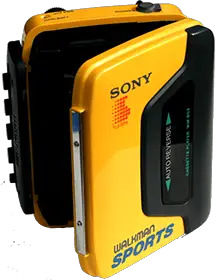
Sony would unveil the iconic yellow walkman which is a pretty interesting story on its own:
Sony had some focus groups that were for a potential new yellow “sports” Walkman to see what people thought. They would ask men and women in focus groups and the initial response was pretty positive as the new Walkman seemed sporty and better than the boring black ones that were now everywhere.
On the way out of the focus group they allowed everyone to take a complimentary walkman and put a bunch of original black ones and the new yellow sports ones on a table.
Everyone took the black ones.
Why would people do this? There came the idea that people just want to be nice to someone who’s being enthusiastic about something new such as how the moderator was being with the new yellow Walkman. And since people were getting on board with the yellow Walkman in the focus group it becomes more difficult to speak up against a group.
Sony wanted to stay with the original yellow color but in
There’s also a sense of “keeping up with the Joneses” as you always want what the other guy’s got. Electronics companies have always had smart ways to create buzz by getting it out there in the public. Companies like Kindle would plant people on subways in major cities like New York and London with their new e-Readers as a way to show it in action. This helps create desire in other people who are witnessing this new
Once people saw others out for a jog with that yellow Walkman in their hands and those yellow headphone in their ears the desire was created.
Whether it’s a shiny pebble or a yellow Walkman people always want the new bright shiny thing.
The Influence Of The Walkman
The impact and the influence of the walkman cannot be understated. It may be the one object that can best define the 1980’s. Everyone had one or had some form of one at some point. It was the perfect combination of portability and privacy. It ran off two AA batteries and could run for quite a while on them as long as you weren’t doing a ton of rewinding.
Remember having to try to end one side in the right place so you weren’t already into the first song on the second side? These were real struggles…
In 1986 the word “Walkman” entered into the Oxford English Dictionary. I also never realized that Walkmans were still being manufactured up until 2010. It was finally discontinued on October 23, 2010 but the units that were made were able to still be sold as there was a demand for them in a bunch of countries.
This has a similar effect on the culture the same way the VCR was having in the 80s. It’s amazing the similar development that happened with the VCR but goes way further back than the Walkman did.
Walkmans and Fitness
This is something that never occured to me until researching this and makes total sense now when you look at it. I’ve worked in fitness for a lot of my life along with spending a lot of time in the gym. If you like to workout can you even picture yourself doing it without music? Today we have our phones and bluetooth headphones and don’t think twice about it but the Walkman helped usher in more people to fitness than Richard Simmons.
Music has become synonymous with working out and there are times when I have forgot my headphones and just left the gym because I don’t think I could workout without music. When the Walkman first hit so did a boom in fitness in the ‘80s. Millions started using the Walkman to exercise from running to training in the gym. People could now listen to what they wanted instead of whatever crap was blaring over the gym speakers.
The Walkman is also seen as creating the aerobics craze and turned more people on to getting fit. From 1987-1997, which was the height of the popularity of the Walkman, the number of people who said they started walking for exercise increased by 30%.
Wrapping It Up

Hopefully this has been a good trip down memory lane for you remembering this iconic device. There’s actually a lot of interesting history behind the Walkman and it’s no doubt cemented itself as a part of pop culture. It lead the way for the discman, the MP3 player, the iPod and to your iPhone (or Android if you’re one of THOSE people)
People were quick to criticize the Walkman in the same way they do with cell phones today saying it would shut kids off from society. I don’t think that happened and maybe we should go easy on the kids today. The phones they have that are apparently so “damaging” are things that their grandkids will laugh at for seeming primitive and we’ll probably look back on them with some nostalgia too.
- You can still track down a modern version of the Walkman if you’re interested here on Amazon- Jensen stereo Walkman cassette player
- Another cool thing is this retro Walkman that converts cassettes to MP3. You can bring those mixtapes back from the dead!- Digital Life Cassette tape to MP3 converter.
Thanks for checking out this blog and if you want to get more epic 80s content like this, do yourself a solid and sign up for the Everything 80s email newsletter!

